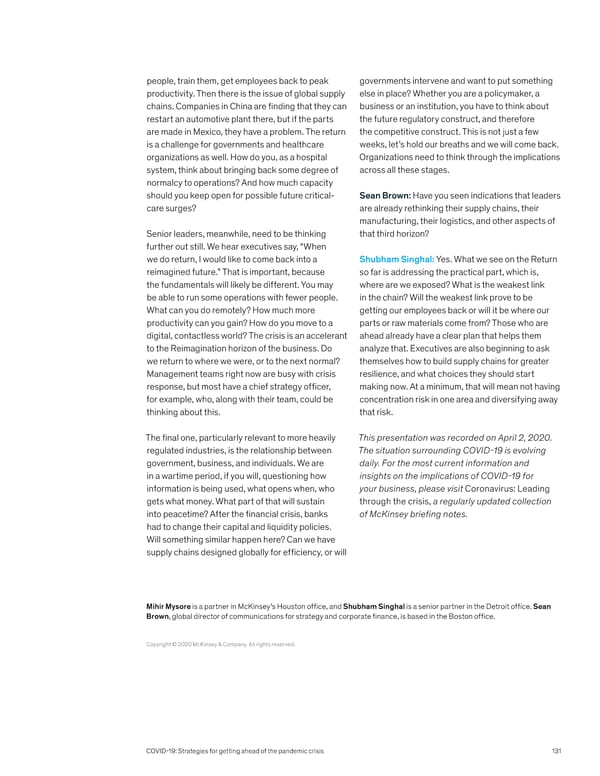people, train them, get employees back to peak governments intervene and want to put something productivity. Then there is the issue of global supply else in place? Whether you are a policymaker, a chains. Companies in China are finding that they can business or an institution, you have to think about restart an automotive plant there, but if the parts the future regulatory construct, and therefore are made in Mexico, they have a problem. The return the competitive construct. This is not just a few is a challenge for governments and healthcare weeks, let’s hold our breaths and we will come back. organizations as well. How do you, as a hospital Organizations need to think through the implications system, think about bringing back some degree of across all these stages. normalcy to operations? And how much capacity should you keep open for possible future critical- Sean Brown: Have you seen indications that leaders care surges? are already rethinking their supply chains, their manufacturing, their logistics, and other aspects of Senior leaders, meanwhile, need to be thinking that third horizon? further out still. We hear executives say, “When we do return, I would like to come back into a Shubham Singhal: Yes. What we see on the Return reimagined future.” That is important, because so far is addressing the practical part, which is, the fundamentals will likely be different. You may where are we exposed? What is the weakest link be able to run some operations with fewer people. in the chain? Will the weakest link prove to be What can you do remotely? How much more getting our employees back or will it be where our productivity can you gain? How do you move to a parts or raw materials come from? Those who are digital, contactless world? The crisis is an accelerant ahead already have a clear plan that helps them to the Reimagination horizon of the business. Do analyze that. Executives are also beginning to ask we return to where we were, or to the next normal? themselves how to build supply chains for greater Management teams right now are busy with crisis resilience, and what choices they should start response, but most have a chief strategy officer, making now. At a minimum, that will mean not having for example, who, along with their team, could be concentration risk in one area and diversifying away thinking about this. that risk. The final one, particularly relevant to more heavily This presentation was recorded on April 2, 2020. regulated industries, is the relationship between The situation surrounding COVID-19 is evolving government, business, and individuals. We are daily. For the most current information and in a wartime period, if you will, questioning how insights on the implications of COVID-19 for information is being used, what opens when, who your business, please visit Coronavirus: Leading gets what money. What part of that will sustain through the crisis, a regularly updated collection into peacetime? After the financial crisis, banks of McKinsey briefing notes. had to change their capital and liquidity policies. Will something similar happen here? Can we have supply chains designed globally for efficiency, or will Mihir Mysore is a partner in McKinsey’s Houston office, and Shubham Singhal is a senior partner in the Detroit office. Sean Brown, global director of communications for strategy and corporate finance, is based in the Boston office. Copyright © 2020 McKinsey & Company. All rights reserved. COVID-19: Strategies for getting ahead of the pandemic crisis 131
 What Now? Page 132 Page 134
What Now? Page 132 Page 134